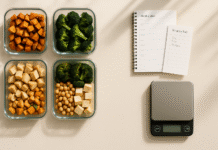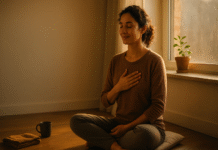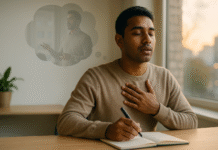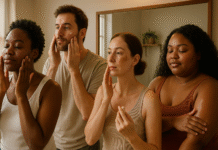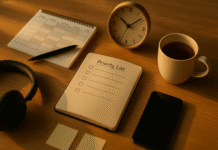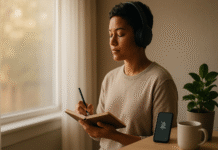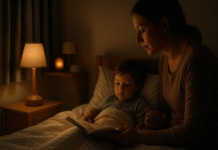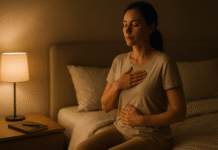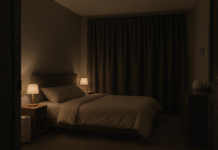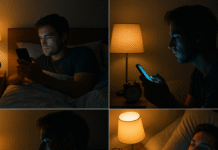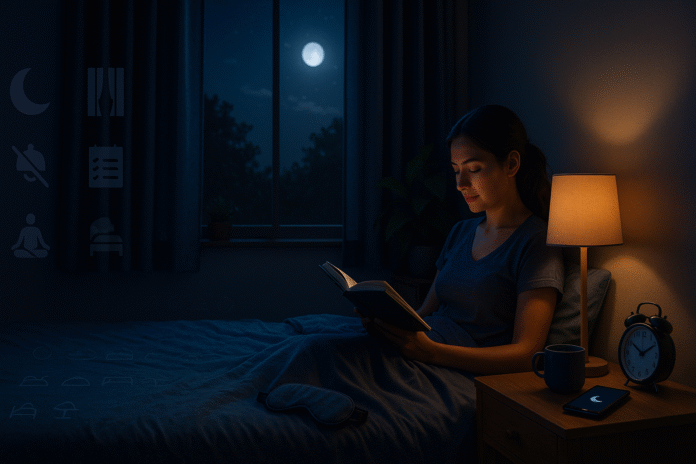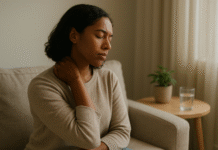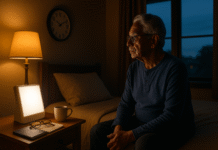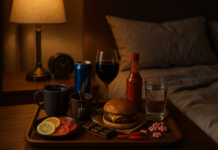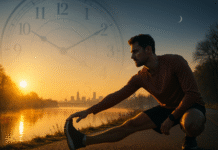If your nights feel like a blur of tossing, turning, and checking the clock, you’re not alone—and you’re not stuck that way. The right nighttime routine can help your brain and body downshift, protect your circadian rhythm, and set the stage for deep, efficient sleep. In the next few minutes, you’ll get a clear, practical, seven-step blueprint for better sleep hygiene—what to do, when to do it, how to scale it, and how to troubleshoot when life gets messy. This guide is written for busy people who want a simple, repeatable system that actually works.
Disclaimer: This article is for general education only and isn’t a substitute for medical advice. If you have persistent insomnia, loud snoring, pauses in breathing, unexplained sleepiness, or other health concerns, talk to a qualified healthcare professional.
Key takeaways
- Consistency beats intensity. A small, repeatable routine—done nightly—trains your brain to expect sleep.
- Set the stage, then slow the brain. Tidy up your environment first (light, temperature, noise), then wind down your mind and body.
- Timing matters. Caffeine, alcohol, screens, exercise, and hot showers affect sleep differently depending on when you do them.
- Use proven techniques. Stimulus control rules, mindfulness, and progressive muscle relaxation help many people fall asleep faster and wake less.
- Measure what matters. Track sleep efficiency, sleep latency, and wake time after sleep onset so you can adjust intelligently.
Step 1: Pick—and protect—a fixed sleep window
What it is & why it works
A consistent bedtime and wake time (including weekends) helps your internal clock anticipate sleep. Hitting a regular “lights-out” window reduces sleep latency (time it takes to fall asleep) and stabilizes deep and REM sleep later in the night. Adults generally do best aiming for at least 7 hours of sleep nightly; most need 7–9 hours to feel and function well.
Requirements / prerequisites
- A realistic wake time anchored to non-negotiables (work, school, morning commitments).
- A bedtime that allows your target sleep duration (e.g., wake at 6:30 a.m. → lights out by ~11:00 p.m. for 7.5 hours).
- Calendar commitment: block 30–60 minutes before lights out for your routine.
How to do it (beginner-friendly steps)
- Choose your wake time first and lock it in for all 7 days.
- Back-calculate bedtime: allow your sleep goal plus 15–30 minutes buffer.
- Set alarms: one for the start of wind-down, one for lights-out.
- Guard the window like an appointment—schedule late tasks earlier or defer them.
Beginner modifications & progressions
- New to routines? Start with a tighter wake time and keep bedtime flexible by ±30 minutes for the first week.
- Progression: After week 1, narrow your bedtime to a 15-minute window (e.g., 10:45–11:00 p.m.) for stronger circadian cues.
Recommended frequency / metrics
- Daily.
- Track sleep latency (goal: ~10–20 minutes) and sleep efficiency (time asleep ÷ time in bed × 100; goal ≥85%).
Safety, caveats & common mistakes
- Don’t “chase sleep” by going to bed extra early after a bad night—keep your schedule stable.
- If you can’t fall asleep within ~20 minutes, follow Step 7’s “in-bed rules.”
Mini-plan example
- 9:45 p.m. wind-down alarm → 10:45 p.m. lights-out alarm → 6:15 a.m. wake → repeat daily.
Step 2: Engineer a sleep-friendly bedroom (light, temperature, sound)
What it is & why it works
Your bedroom should be dark, cool, and quiet. Darkness prevents late-evening light from delaying your body clock. A slightly cool room supports your body’s natural drop in core temperature that helps initiate sleep. Minimizing sudden noises cuts down on awakenings.
Requirements / prerequisites
- Light: blackout curtains or an eye mask; dimmable bedside lamp.
- Temperature: a thermostat you can set near the mid-60s °F (~18–20°C), breathable bedding, or a fan.
- Sound: earplugs, a noise-masking device, or a simple fan.
How to do it (beginner-friendly steps)
- Darken the room fully—no LEDs glowing, no hallway light leaking in.
- Cool the space to roughly ~65–68°F (18–20°C) and use breathable layers.
- Quiet the environment: mask noise with a fan or steady sound if needed.
- Declutter your nightstand; keep only essentials (book, lamp, water).
Beginner modifications & progressions
- If you can’t control the thermostat, use lighter bedding, open a window (if safe), or run a fan.
- If blackout curtains are not feasible, eye masks are a low-cost alternative.
- For sound, try soft earplugs if a fan is too chilly or inconvenient.
Recommended frequency / metrics
- Nightly.
- Check nighttime awakenings and wake after sleep onset (WASO). Fewer and shorter awakenings suggest your environment is dialed in.
Safety, caveats & common mistakes
- Don’t overcool to discomfort; shivering disrupts sleep.
- Avoid scented candles or diffusers if you’re sensitive to fragrances.
Mini-plan example
- 30 minutes before bed: close curtains, set thermostat to 18.5°C, place eye mask and earplugs within reach.
Step 3: Run a “digital sunset” and set stimulant cutoffs (caffeine, alcohol, nicotine)
What it is & why it works
Bright screens and interactive content keep your brain alert and suppress melatonin close to bedtime. Caffeine can disrupt sleep even 6 hours before bed. Alcohol shortens time to sleep but fragments the second half of the night and reduces REM. Nicotine is a stimulant and can also disturb sleep.
Requirements / prerequisites
- Phone settings or apps to schedule night mode and downtime.
- A caffeine, alcohol, and nicotine cutoff plan.
How to do it (beginner-friendly steps)
- Digital sunset: power down TVs, tablets, and phones 60 minutes before lights out. If you must use a device, dim it and keep it at least arm’s length.
- Caffeine cutoff: stop caffeine ≥6 hours before bedtime; keep total daily intake sensible.
- Alcohol cutoff: avoid alcohol near bedtime; if you drink, give yourself several hours before lights out and hydrate.
- Nicotine: avoid within several hours of bed; seek quitting support if you use tobacco regularly.
Beginner modifications & progressions
- Level 1: Use “Do Not Disturb” and grayscale mode after your digital sunset.
- Level 2: Move chargers out of the bedroom; put devices to bed in another room.
- Level 3: Replace scrolling with light reading or Step 6 relaxation.
Recommended frequency / metrics
- Daily.
- Track sleep latency and how many times you reach for your phone at night (aim for zero).
Safety, caveats & common mistakes
- Blue-light filters help a bit but don’t fully offset the cognitive arousal of content.
- Alcohol is not a sleep aid; it may worsen sleep later in the night.
Mini-plan example
- 9:45 p.m. devices off; last caffeinated drink by 4:00 p.m.; skip nightcap; nicotine-free after dinner.
Step 4: “Empty your head” ritual—lists, light planning, and micro-declutter
What it is & why it works
Racing thoughts and tomorrow’s to-dos are classic sleep stealers. A 5-minute brain dump—especially a specific to-do list—reduces pre-sleep cognitive load so your brain can let go.
Requirements / prerequisites
- Pen and paper (or a simple notes app if needed—paper is better near bedtime).
- A small tray or basket to gather items so your room looks “done.”
How to do it (beginner-friendly steps)
- Spend 5 minutes writing tomorrow’s to-do list—keep it specific.
- Highlight top 3 tasks; schedule time blocks for them in the morning.
- Do a two-minute tidy—put away clothes, set out tomorrow’s outfit, fill your water.
Beginner modifications & progressions
- If lists make you anxious, switch to a “done for today” reflection: three things you completed and one you’ll start tomorrow.
- Progress by time-boxing: 5 minutes list, 2 minutes tidy, done.
Recommended frequency / metrics
- Nightly.
- Note how quickly you fall asleep after list-making; many people see shorter sleep latency over time.
Safety, caveats & common mistakes
- Don’t map the entire week—keep it short to avoid reactivating your brain.
- Keep the list outside the bedroom if it tempts you to keep working.
Mini-plan example
- 9:50–9:55 p.m. to-do list → star top three → 9:55–9:57 p.m. tidy → lights dim.
Step 5: Warm bath or shower + gentle mobility to trigger “sleep mode”
What it is & why it works
A warm bath or shower 60–90 minutes before bed can help you fall asleep faster by nudging your body’s temperature regulation—warm up first, then cool down as you dry off. Add light stretching or mobility to release physical tension.
Requirements / prerequisites
- Access to a shower/tub; timer on your phone.
- A short list of gentle stretches (neck rolls, hamstring stretch, child’s pose).
How to do it (beginner-friendly steps)
- Take a warm (not scalding) shower/bath for 10–20 minutes, about 1–1.5 hours before lights out.
- Afterward, keep the bedroom cool so your body can gradually shed heat.
- Do 5–10 minutes of gentle stretching or foam rolling.
Beginner modifications & progressions
- No tub? A warm foot bath plus a quick shower works.
- Very hot climate? Shorten shower time and rely more on cooling the room.
Recommended frequency / metrics
- 3–7 nights per week, experiment with timing; note sleep latency and perceived relaxation (0–10 scale).
Safety, caveats & common mistakes
- Avoid overheating (bright red skin, dizziness).
- If you exercise in the evening, leave at least ~1 hour after vigorous workouts before lights out; cool down well.
Mini-plan example
- 9:15 p.m. shower → cotton pajamas → 5-minute stretch → dim lights.
Step 6: A 10-minute relaxation practice (breathwork, body scan, or progressive muscle relaxation)
What it is & why it works
A short, structured relaxation practice calms the nervous system and interrupts rumination. Good options include slow breathing, a body scan, or progressive muscle relaxation (PMR)—tensing and releasing muscle groups to “turn off” tension.
Requirements / prerequisites
- A quiet space; optional audio guidance or timer.
- Comfortable position: seated or lying on your back.
How to do it (beginner-friendly steps)
- Pick one technique for a week to learn it well.
- Breathwork (box breath): inhale 4, hold 4, exhale 4, hold 4 → repeat for 10 minutes.
- Body scan: bring attention from toes to head, 10–20 seconds per area, noticing sensations.
- PMR: tense a muscle group for ~5 seconds, release for ~10–15 seconds; move feet → calves → thighs → abdomen → hands → arms → shoulders → face.
Beginner modifications & progressions
- Start with 4–6 minutes if 10 feels long; build up.
- Progress by pairing two techniques (e.g., breath + short PMR).
Recommended frequency / metrics
- Nightly, preferably during wind-down (not necessarily in bed).
- Track pre/post tension rating (0–10) and sleep latency.
Safety, caveats & common mistakes
- PMR: skip tensing areas with pain or injury.
- If focusing inward ramps up anxiety, keep eyes open and focus on a visual anchor like a candle (safe placement).
Mini-plan example
- 10:05–10:15 p.m. PMR with a guided audio → lights out at 10:45 p.m.
Step 7: In-bed rules that retrain your brain (stimulus control)
What it is & why it works
Stimulus control reconnects bed = sleep by removing wakeful activities and breaking the loop of tossing and turning. It’s a core component of behavioral insomnia treatments.
Requirements / prerequisites
- A chair or cozy nook outside the bed for “can’t-sleep moments.”
- A quiet, low-stimulation activity ready (paperback, calm music, breathing).
How to do it (beginner-friendly steps)
- Go to bed only when sleepy. If you’re wired, do Step 6 a few minutes longer.
- Use the bed for sleep (and intimacy) only. No work, no streaming, no news.
- If you can’t sleep within ~20 minutes, get out of bed. Sit somewhere dim. Do a calm activity until you feel sleepy again. Repeat as needed.
- Wake time stays fixed even after a rough night (no sleeping in).
Beginner modifications & progressions
- If you’re unsure about “20 minutes,” use a gentle timer or just the sense of restlessness as your cue.
- Progress by shrinking the number of in-bed wakeful minutes week over week.
Recommended frequency / metrics
- Always.
- Watch sleep efficiency improve as you cut time awake in bed.
Safety, caveats & common mistakes
- Don’t turn on bright lights when you get up; keep it dim.
- Avoid checking the clock—it fuels anxiety.
Mini-plan example
- 10:45 p.m. lights out. If still awake, 11:05 p.m. move to chair, read 10 minutes, return when drowsy.
Quick-start checklist (print or screenshot)
- Set one wake time for the next 14 days.
- Choose a lights-out window that allows 7–9 hours of sleep.
- Schedule a digital sunset 60 minutes before bed.
- Prep your room: dark, cool (~18–20°C), quiet.
- Do a 5-minute to-do list and a 2-minute tidy.
- Take a warm shower/bath (10–20 min) 60–90 minutes before bed.
- Practice 10 minutes of relaxation (breath, body scan, or PMR).
- Follow stimulus control: out of bed if you can’t sleep.
Troubleshooting & common pitfalls
“I did everything right and still had a bad night.”
Normal. Sleep varies. Stick to your wake time; tonight isn’t a referendum on your routine.
“I fall asleep fine but wake at 3 a.m.”
Check room temperature and evening fluids; consider a shorter digital sunset; try a brief relaxation reset (slow breathing) without turning on lights.
“Evening workouts wreck my sleep.”
Experiment with timing. Many people are fine if vigorous exercise ends ~1 hour before bed. Cool down thoroughly and shower earlier in Step 5.
“Caffeine is my lifeline—help.”
Gradually move your last dose earlier by 30–60 minutes per day until it’s ≥6 hours before bed. Keep daily intake reasonable.
“Nightcap makes me sleepy—why stop?”
It can help you doze off but often disrupts the second half of the night and reduces REM. Try an alcohol-free week and compare your data.
“I quit nicotine and my sleep got worse.”
Withdrawal can temporarily fragment sleep. Keep your routine steady; most people improve within a few weeks. Seek support if needed.
“Lists wind me up.”
Switch to a “done for today” reflection or gratitude note, and time-box your writing to 3 minutes.
“I can’t stop doomscrolling.”
Automate it: schedule app limits and put your charger in another room. Keep a paperback by the bed as your “default.”
How to measure progress (so you can adjust like a pro)
Sleep diary basics
Spend two minutes each morning noting:
- Time in bed and lights out
- Sleep latency (minutes to fall asleep)
- Number/duration of awakenings
- Wake time & out-of-bed time
- Estimated total sleep time
- Daytime sleepiness (0–10) and caffeine/alcohol/nicotine use
Key metrics
- Sleep efficiency (SE): total sleep time ÷ time in bed × 100. Target ≥85%.
- Sleep latency (SL): time to fall asleep. Target ~10–20 minutes.
- WASO: total minutes awake after initially falling asleep. Lower is better.
What to look for over 2–4 weeks
- Is SE trending up? Great—keep the routine.
- If SE is <80% for a week, tighten bedtime slightly (reduce time in bed by 15–30 minutes) and reinforce stimulus control.
- If SL is long only on phone-heavy nights, deepen your digital sunset.
A simple 4-week starter plan
Week 1: Foundations & environment
- Fix your wake time and approximate lights-out window.
- Make the bedroom dark, cool, and quiet; test eye mask/earplugs.
- Start a 5-minute to-do list ritual and 2-minute tidy.
- Track a basic sleep diary; don’t chase perfection.
Week 2: Relaxation & showers
- Add a 10-minute nightly relaxation practice (pick one).
- Experiment with a warm shower/bath 60–90 minutes before bed.
- Move caffeine cutoff earlier until it’s ≥6 hours before bedtime.
- Keep wake time fixed even after rough nights.
Week 3: Stimulus control mastery
- Enforce in-bed rules: out of bed if not sleepy; bed = sleep/intimacy only.
- Relocate chargers; extend digital sunset to a full hour.
- Review diary: if SE <80%, trim time in bed by 15–30 minutes.
Week 4: Fine-tune & lock habits
- Adjust room temp and bedding for comfort and fewer awakenings.
- Trial alternate relaxation (e.g., switch from breathwork to PMR).
- Confirm SE ≥85% and SL ~10–20 min on most nights.
- Set a maintenance plan: pick the few habits that move the needle most for you and commit to them.
FAQs
1) How long until I notice better sleep?
Many people feel improvements within 1–2 weeks, especially in falling asleep faster. Deeper changes (fewer awakenings, better daytime energy) often solidify over 3–4 weeks of consistency.
2) What’s the best room temperature for sleep?
A cool bedroom around the mid-60s °F (about 18–20°C) suits most adults. Use layers so you’re warm enough to relax without overheating.
3) Do blue-light glasses fix screen-related sleep problems?
They may reduce glare and some blue light, but the bigger issue is arousing content and overall brightness. A true digital sunset works better.
4) Is it okay to nap if I slept badly?
Short, early-afternoon naps of 10–20 minutes can help some people. Avoid late or long naps that undercut sleep pressure at night.
5) I exercise at night. Will that ruin my sleep?
Not necessarily. Many people tolerate evening exercise just fine, especially if vigorous sessions wrap up ~1 hour before bed and you cool down well.
6) Can a warm bath really help?
Yes—taken 60–90 minutes before bed, a warm bath or shower can help you fall asleep faster by promoting a gentle drop in core temperature afterward.
7) Are melatonin or magnesium good ideas?
They can be helpful for specific situations (e.g., sleep timing issues like jet lag). For chronic insomnia, behavioral approaches are first-line. Always check with a clinician before starting supplements.
8) What’s the single most important habit?
A fixed wake time. It anchors your internal clock and strengthens all your other nighttime cues.
9) Should I stay in bed and “push through” if I can’t sleep?
No. If you’re not sleepy after ~20 minutes, get up and do something calm in dim light. Return only when sleepy. This retrains your brain that bed = sleep.
10) How much caffeine is too much—and when should I stop?
Daily tolerance varies, but many adults do best keeping caffeine moderate and stopping ≥6 hours before bedtime.
11) Does alcohol really hurt sleep if it helps me doze off?
Often, yes. It tends to fragment the second half of the night and reduce REM, leaving you less restored by morning.
12) I quit nicotine and my sleep feels worse—what now?
That’s common short term. Keep your routine steady, lean on relaxation, and get support—sleep usually improves after the initial withdrawal period.
Conclusion
A great night’s sleep is less about hacks and more about habits. When you pair a consistent sleep window with a practical wind-down, a sleep-friendly environment, and smart in-bed rules, you give your brain the clear, repeated message it needs to do what it does best: sleep. Start with one or two steps tonight, track what changes, and build your personal routine from there.
Copy-ready CTA: Start your 14-night experiment tonight—set your wake time, schedule a 60-minute digital sunset, and follow the seven steps before bed.
References
- About Sleep, Centers for Disease Control and Prevention, May 15, 2024. https://www.cdc.gov/sleep/about/index.html
- FastStats: Sleep in Adults, Centers for Disease Control and Prevention, May 15, 2024. https://www.cdc.gov/sleep/data-research/facts-stats/adults-sleep-facts-and-stats.html
- Caffeine Effects on Sleep Taken 0, 3, or 6 Hours before Going to Bed, Journal of Clinical Sleep Medicine (PMC), Nov 2013. https://pmc.ncbi.nlm.nih.gov/articles/PMC3805807/
- Evening Use of Light-Emitting eReaders Negatively Affects Sleep, Circadian Timing, and Next-Morning Alertness, Proceedings of the National Academy of Sciences, Jan 2015. https://www.pnas.org/doi/10.1073/pnas.1418490112
- The Best Temperature for Sleep, Sleep Foundation, July 11, 2025. https://www.sleepfoundation.org/bedroom-environment/best-temperature-for-sleep
- Effects of Evening Exercise on Sleep in Healthy Participants: A Systematic Review and Meta-Analysis, Sports Medicine (Springer/PubMed), 2019. https://pubmed.ncbi.nlm.nih.gov/30374942/
- Management of Chronic Insomnia Disorder in Adults, Annals of Internal Medicine (American College of Physicians), May 3, 2016. https://www.acpjournals.org/doi/10.7326/M15-2175
- New Guideline Supports Behavioral, Psychological Treatments for Insomnia, American Academy of Sleep Medicine, Dec 16, 2020. https://aasm.org/new-guideline-supports-behavioral-psychological-treatments-for-insomnia/





